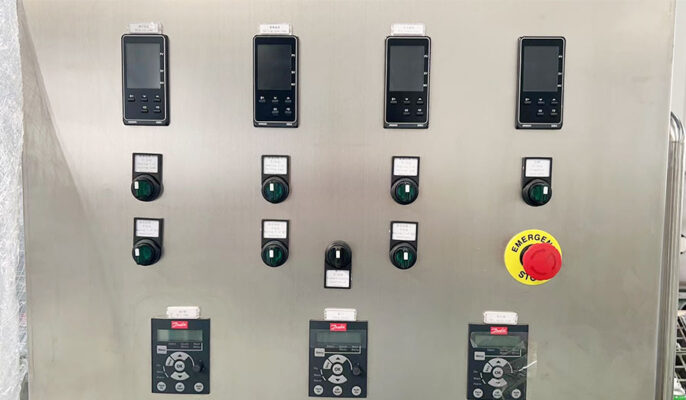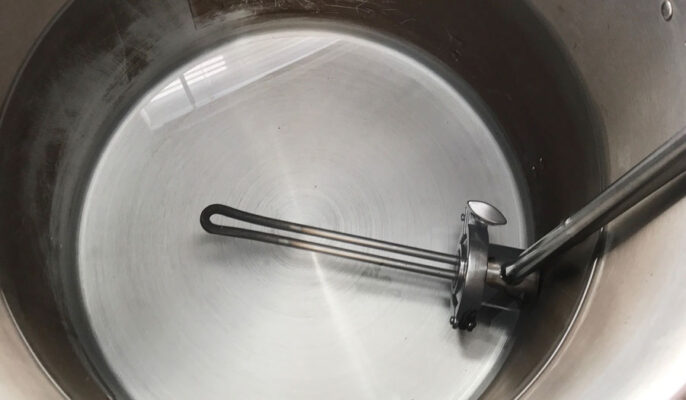Při vaření piva je kontrola kvašení jedním z klíčových kroků k zajištění kvality piva. Během procesu kvašení kvasinky přeměňují cukr na alkohol a plynný oxid uhličitý, čímž vzniká jedinečné nadšení z piva. Teplota procesu kvašení ovlivňuje chuť a vůni konečného produktu. Rychlost kvašení závisí na řadě faktorů, včetně typu použitých kvasinek, množství cukru a teploty. Někteří pivovarníci dávají přednost kvašení piva při nízkých teplotách, aby zachovali jeho jemnou chuť, zatímco jiní volí kvašení při vyšších teplotách, aby dosáhli rychlejšího a silnějšího kvašení.
Proč je důležitá regulace teploty kvašení?
Udržování správné teploty kvašení je důležité z následujících důvodů. Zaprvé, aktivita kvasinek je velmi závislá na teplotě a různé kmeny kvasinek mají specifické teplotní rozmezí pro optimální výkon. Kontrola teploty umožňuje pivovarníkům vytvořit prostředí, které podporuje požadovaný metabolismus kvasinek a produkci chuti. Příliš vysoká teplota navíc může vést k nepříjemným příchutím, zatímco nízká teplota může zpomalit nebo dokonce zastavit kvašení, což má za následek nedostatečně prokvašené pivo.
- Ovlivnění aktivity a produktů kvasinek: Kvasinky vykazují při různých teplotách různou aktivitu. Příliš nízké teploty kvašení mohou způsobit zpomalení aktivity kvasinek, prodloužení doby kvašení a ovlivnění výtěžnosti a kvality piva. Příliš vysoké teploty kvašení mohou způsobit, že kvasinky produkují nežádoucí vedlejší produkty, jako jsou špatné chutě a zápach.
- Ovládejte chuť a vůni piva: Různé druhy piva musí být kvašeny v určitém teplotním rozmezí, aby se vytvořily specifické chutě a vůně. Například ležák se obvykle kvasí při nižší teplotě, která pomáhá vytvářet osvěžující a čistou chuť, zatímco pivo typu ale se kvasí při vyšší teplotě, která může vytvářet ovocnější a komplexnější aroma.
- Kontrolujte rychlost a dobu kvašení: Správná teplota kvašení může zajistit mírnou rychlost kvašení a zabránit příliš rychlému nebo příliš pomalému kvašení. Příliš rychlé kvašení může vést k nedostatečnému rozvinutí chuti, zatímco příliš pomalé kvašení zvyšuje výrobní a časové náklady.
- Vyhněte se nežádoucím reakcím a kontaminaci: Kvašení při vhodné teplotě snižuje riziko nežádoucích chemických reakcí a mikrobiální kontaminace a pomáhá udržet pivo čisté a stabilní.

Co se stane, když se teplota kvašení zvýší nebo sníží?
Vyšší teploty kvašení
Kvašení piva při příliš vysoké teplotě může způsobit nadměrnou aktivitu kvasinek. V takovém případě kvasinky produkují řadu produktů, které nejsou pro výsledné pivo dobré. Patří mezi ně fuselové alkoholy, které dodávají pivu "alkoholickou" chuť. Vyšší teploty kvašení také zvyšují množství esterů produkovaných kvasinkami. Estery jsou dalším produktem, který je považován za charakteristický pro kvasinky; mají různou chuť, například hřebíčku, banánů a koření.
Obecně platí, že "neutrální" kmeny kvasinek kvašené při příliš vysoké teplotě produkují méně chutné estery, takže kvašení při stálé ideální teplotě povede k lepšímu výslednému produktu. Některé specifičtější kmeny, jako například kmeny používané k výrobě pšeničných piv, belgických stylů a farmářských piv, produkují estery, které jsou pro tyto specifické styly žádoucí, i při kvašení za tepla. V těchto případech lze použít kvašení v teplejším prostředí, aby se v konečném produktu objevilo více kvasinek.
Příliš nízké teploty kvašení
Pokud je teplota kvašení pro určité kvasinky příliš nízká, jejich metabolismus se zpomalí a jejich aktivita se sníží. Výsledkem je často pivo, které není dostatečně aktivní, aby dokončilo kvašení. To může způsobit "stagnaci" kvasinek, takže pivo je prokvašené jen napůl a výsledný produkt má sladkou chuť. To není nejhorší, pokud pivo stáčíte do sudů, ale může to představovat bezpečnostní riziko, pokud pivo stáčíte do lahví. Protože je v roztoku zbytkový zkvasitelný cukr, mohou ho kvasinky při zvýšení teploty spotřebovat. Pokud k tomu dojde v lahvi a přidá se další zákvasný cukr, hrozí riziko výbuchu lahve nebo překysličení piva.
Jak regulovat teplotu během fermentace?
Topná zařízení
V chladnějším podnebí nebo u některých druhů piva, které vyžadují vysoké teploty, mohou pivovary během kvašení použít metody ohřevu. Ke zvýšení teploty v kvasné nádobě se často používají elektrická topná tělesa, parní kabely nebo horké vodní kabely. Udržováním požadovaného rozsahu teplot mohou pivovary zajistit optimální aktivitu kvasinek a dosáhnout požadovaného chuťového profilu. Ohřívací zařízení může podle potřeby zajistit správné teplotní prostředí, aby kvasinky byly aktivní a rostly ve správném teplotním rozmezí.
Chladicí systémy
Pivovary využívají různé chladicí systémy k regulaci teploty kvašení. Nejběžnější metodou je použití glykolového chladicího systému, který cirkuluje ochlazený glykol přes chladicí plášť nebo cívku v kvasné nádobě. To umožňuje přesnou regulaci teploty pomocí regulace teploty glykolu. Další možností chlazení je výměník tepla, který k chlazení fermentační nádoby používá chladicí médium, například studenou vodu nebo chladivo. Tato zařízení účinně regulují teplotu fermentace průchodem chladicího média vnějšími stěnami nádoby. fermentor nebo vnitřní chladicí cívky.
Teplotní sondy a řídicí systémy
Pro zajištění přesné regulace teploty se pivovary spoléhají na zařízení pro sledování teploty, jako jsou teploměry, termočlánky nebo teplotní sondy. Teplotní sondy se používají během kvašení ke sledování změn teploty ve fermentoru v reálném čase. Tyto sondy lze připojit k systému řízení teploty, jako je PID regulátor nebo inteligentní řídicí systém.
Systém regulace teploty může automaticky nastavit chladicí nebo topné zařízení podle předem nastaveného teplotního rozsahu, aby se udržovala ideální teplota fermentace. Kromě toho vinař sleduje teplotu v průběhu celého procesu kvašení a může ji podle potřeby postupně upravovat, například zvyšovat teplotu pro diacetylový klid nebo snižovat teplotu pro studený pád.
Fermentační box nebo fermentační komora
Fermentační box nebo fermentační komora je zařízení speciálně navržené pro regulaci teploty kvašení. Obvykle jsou vybaveny systémem regulace teploty a izolací pro přesné nastavení a udržování teploty uvnitř fermentačního sudu nebo fermentační nádrže.
Fermentační box může nastavením požadované teploty zajistit teplotní stabilitu během procesu fermentace. Tato metoda je vhodná pro velkovýrobu a vinařské provozy, které vyžadují přesnou kontrolu.
Kontrola stavu prostředí
Pokud není k dispozici specializované zařízení, lze teplotu fermentace regulovat úpravou podmínek prostředí, v němž je fermentační nádrž umístěna. Fermentační nádrž může být například umístěna v místnosti se stálou teplotou nebo ve sklepě, aby se zabránilo přímému slunečnímu záření a kolísání teploty.

Tipy pro teplotu kvašení
Zvyšování teploty kvašení
- Zabalte fermentor do něčeho, jako je spací pytel nebo izolovaná deka. Zabalením fermentoru se v něm udržuje teplo vznikající při kvašení kvasinek, což způsobuje zvýšení teploty.
- Pro podobný efekt umístěte fermentor do kartonové krabice nebo izolované místnosti.
- Dalším způsobem regulace teploty je ponoření fermentoru do kbelíku s vodou a použití akvarijního ohřívače k udržení teploty.
Snížení teploty kvašení
- Nejjednodušší metodou je zabalení fermentoru do vlhkého ručníku. Jak se voda odpařuje, vnější strana fermentoru se ochlazuje.
- Pokud to nefunguje, můžete fermentor umístit do hloubky asi 1 až 2 cm vody a zabalit jej do vlhkého ručníku, přičemž se ujistěte, že se ručník dotýká vody. Tím zajistíte stálý přísun vlhkosti pro odpařování.
- Do vody můžete také přidat kostky ledu nebo zapnout ventilátor, aby se voda ještě více ochladila. Karafu můžete také ponořit do kbelíku s vodou a použít ledový obklad ke snížení teploty. Abyste udrželi stálou teplotu, budete muset sáček s ledem pravidelně vyměňovat.
Co mám dělat, když pivo dokvasí?
Doporučuje se nechat pivo po kvašení několik dní odstát. To umožní, aby se pivo usadilo, kvasinky na dně kvasné nádoby flokulačily a pivo zprůhlednělo. Pokud můžete mírně snížit teplotu, doporučujeme to udělat, protože to pomůže projasnit pivo.
Po dokončení kvašení se můžete rozhodnout, zda jej ihned zabalíte, necháte delší dobu zrát nebo přidáte další přísady, jako je ovoce, dub, nebo u některých ležáků samotný. Vše záleží na druhu piva, které vaříte.
Závěr
Řízení teploty je rozhodujícím faktorem úspěšného kvašení a hraje důležitou roli při dosažení požadované chuti a vlastností piva. Pomocí chladicího systému nebo zdroje tepla mohou pivovary udržovat přesné a stálé teploty kvašení. Pochopení specifických teplotních požadavků různých kmenů kvasinek a typů piva je pro pivovarníky zásadní pro výrobu vysoce kvalitních a chuťově výrazných piv. Sledování teplot kvašení a jejich případná úprava umožňuje pivovarníkům udržet zdraví kvasinek, vyhnout se nepříjemným příchutím a vyrábět pivo vynikající kvality.




